Ice Box Challenge: Standard code vs Passive House design
Standard building codes go head-to-head with Passive House design. Who will win?
Two multi-colored tiny houses have popped up in Brussels, New York City, Seattle, Vancouver, Pittsburgh and Washington, D.C., as part of the Ice Box Challenge.
The Ice Box Challenge is an environmental public art installation touring the world and demonstrating the merits of Passive House design, a set of green building and construction design principles.
What is the Ice Box Challenge?
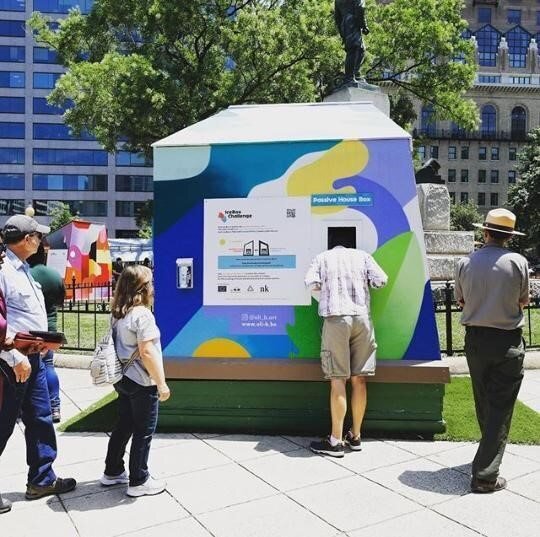
Image courtesy of East Coast Ice Box Challenge
The Ice Box Challenge comprises two small structures: one built to standard building codes and the other built to the high energy-efficiency Passive House Standard. Resembling a tiny, colorful house, each “Ice Box” contains 1,800 pounds of ice and is left outside in the sun for approximately three to four weeks. At the end of the month, the boxes are opened, and the remaining ice is measured to demonstrate how a Passive House building reduces heat and cooling loss to create a more controllable, comfortable environment.

“Better building design through the Passive House standard can help us reduce our carbon pollution without changing our behavior. These energy-efficient homes are reliable, affordable, comfortable buildings that keep the indoors in and the outdoors out. We’re hoping the Ice Box Challenge helps people discover the benefits of this design method,” said BLUPATH Principal Laura Blau, AIA CPHC CPHB.
The opening of the boxes is an educational event, with organizers speaking on the merits of energy-efficient buildings and showing off just how much ice has melted in a building code standard ice box vs. the Passive House ice box.

Image courtesy of Instagramer eesmyal
What is the Ice Box Challenge Contest?
Every time the ice boxes drop down to visit a new city, the public is invited to join the Ice Box Challenge by visiting the two Ice Boxes throughout the challenge and peek into the boxes to see how the ice is melting. Those who are 18 and older are encouraged to go to the Ice Box Challenge website and guess how much ice they think will remain in both boxes at the end of the challenge. The contestant to guess closest to the final weight will receive a prize.
Where in the World Can You Find the Ice Box Challenge?
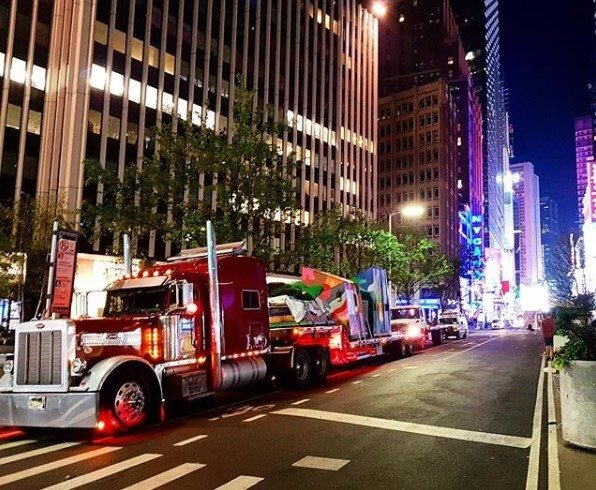
Image courtesy of East Coast Ice Box Challenge
The Ice Box Challenge has visited cities along the West and East Coast of North America. If you’re looking for its current location, visit the Ice Box Challenge Tour Page.
The boxes are always on the move, so check back periodically to learn if they are scheduled to head to a city near you. We’ve heard they might be heading to the Midwest in the U.S. next…
Ice Box Challenge in New York City

Image courtesy of East Coast Ice Box Challenge
The Big Apple was the first stop for the Ice Boxes on their tour of the East Coast. There the Ice Boxes caught the attention of those walking just a few blocks from bustling Times Square.
How did the Ice Box Challenge perform in NYC?
After one month out in the sun, the standard building code box only had 126 pounds of ice left inside. That’s 7% of its original 1,800 pounds!
Yet in the very same weather conditions, the 1,800 pounds of ice in the Passive House box only melted to 756 pounds That’s 42% of its original 1,800 pounds!
Ice Box Challenge in Philadelphia
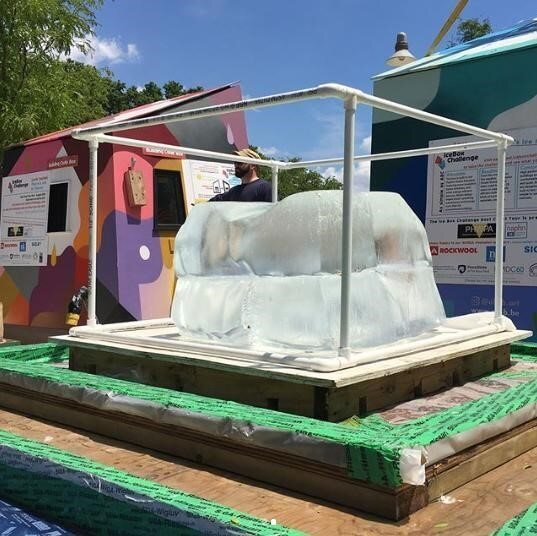
Image courtesy of Alyssa Swisher of NK Architects
Temperatures rose in Philly, making the month the Ice Box Challenge was running a hot one. And it wasn’t just hot outside. A thermometer kept us up to date on the situation within the ice boxes.
You can see below that in mid-June the temperature inside the standard code ice box starts to drastically increase. Eventually it got hotter inside the box than it was outside in the open air.

Image courtesy of East Coast Ice Box Challenge
After one month, the 1,800 pounds of ice in the standard building code box had completed melted!
The Passive House ice box had about 300 pounds of ice remaining.
Ice Box Challenge in Washington, D.C.
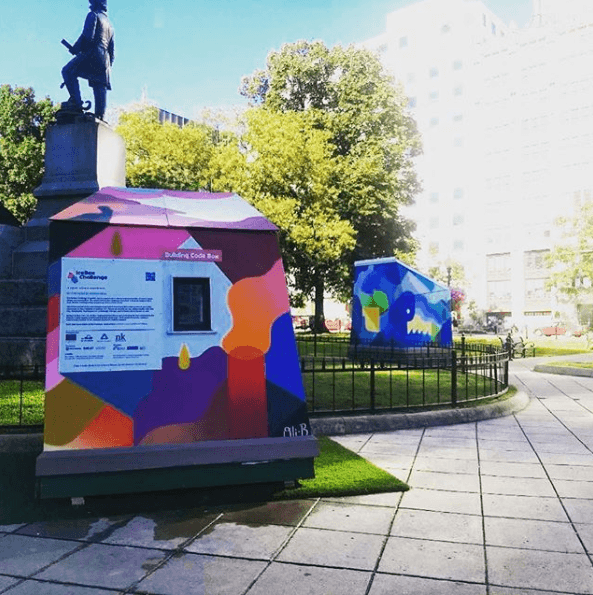
Image courtesy of East Coast Ice Box Challenge
The Ice Box Challenge once again proved the power of Passive House design, and this time the demonstration was just a few blocks from the White House in Farragut Square.
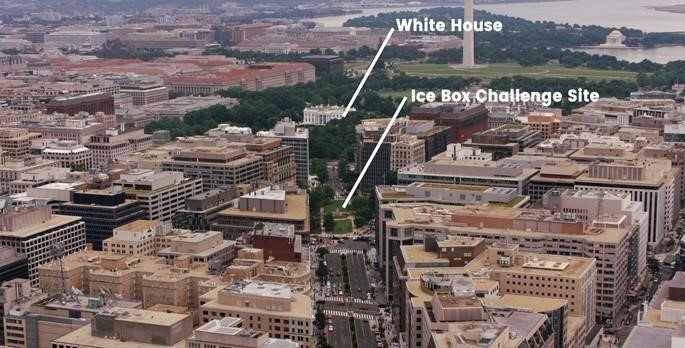
After two weeks in the hot July summer sun, only 460 pounds of ice remained in the standard code-built box out of the original 1,800 pounds
How much ice was left in the Passive House-standard box?
A whopping 838 pounds!
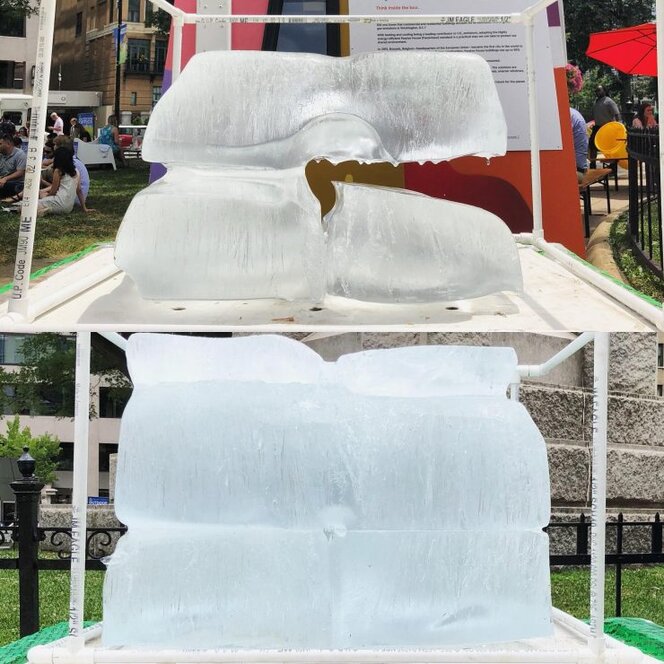
Image Courtesy of East Coast Ice Box Challenge
How are the Ice Boxes Built?
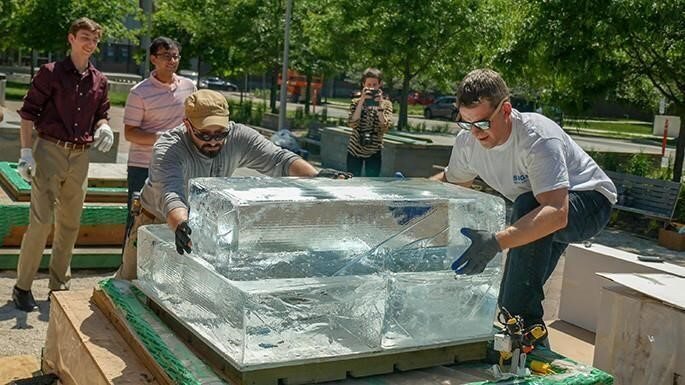
Image Courtesy of Joe Black Media
Stark Architecture designed the original Ice Boxes after being inspired by The Lions Peak in Vancouver. A Belgian street artist, Oli-B, gave the boxes their current colorful flare in New York City.
The Ice Boxes are built with timber studs and plywood. They sit on separate platforms and are both clad in treated oriented strand board, which is then painted and waterproofed.
The Passive House Ice Box is over-insulated with Rockwool Insulation, and the window is triple-glazed, according to the Passive House Standard.
The air sealing in the Passive House Box was donated by SIGA. The team used Wigluv® and Rissan® high-performance tape for the window flashing and sealing the base.
The Ice Boxes and platforms are built off site and then delivered and assembled on site in each location. Shaun St-Amour (Pictured on the right above) of Footprint Sustainable Housing Corporation was instrumental with the setup.
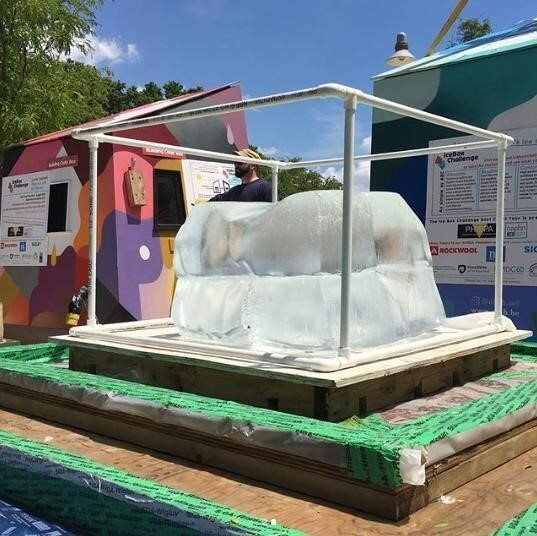
Image Courtesy of East Coast Ice Box Challenge
“The Ice Box Challenge is a great way to demonstrate that the Passive House Standard is the answer to build more energy-efficient, sustainable and comfortable buildings,” said Etienne Gubler, CPHC, CEO of SIGA North America.
Who Organized the Ice Box Challenge Tour?
Taking the Ice Box Challenge on tour was the brainchild of NK Architects, a top architecture firm working to design energy-saving buildings that are healthier for people and the planet.
Each location received sponsorships from building material manufacturers, members of the building and construction industry, and organizations interested in promoting sustainability.
Sponsors and partners included:
- The European Union
- be.brussels
- Golden Triangle BID
- Rockwool
- SIGA
- Cascadia Windows and Doors
- Crux Homes
- Passive House Western Pennsylvania
- North American Passive House Network
Conclusion
The Ice Box Challenge represents a growing movement to take practical steps toward more energy-efficient construction. Better insulation, air sealing and weatherization don’t impact the day-to-day lives of occupants, yet with relatively low up-front costs, comfort increases and utility costs decrease. The benefits are also felt immediately and continue for the life of the building.
Jessica Kumor
Jessica is SIGA North America's Marketing Director. It's her job to deliver you the latest research and practical tips for building air and weathertight buildings. When she's not interviewing customers and posting about building science you can find her refinishing furniture.